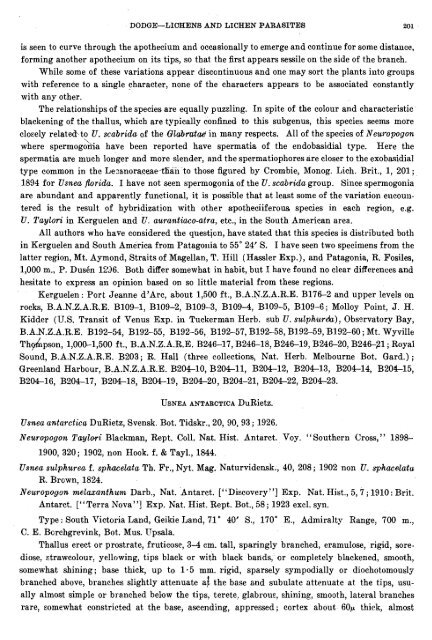Create successful ePaper yourself
Turn your PDF publications into a flip-book with our unique Google optimized e-Paper software.
DODGE-<strong><strong>LICHEN</strong>S</strong> <strong>AND</strong> <strong>LICHEN</strong> <strong>PARASITES</strong> 201<br />
is seen to curve through the apothecium and occasionally to emerge and continue for some distance,<br />
forming another apothecium on its tips, so that the first appears sessile on the side of the branch.<br />
While some of these variations appear discontinuous and one may sort the plants into groups<br />
with reference to a single character, none of the characters appears to be associated constantly<br />
with any other.<br />
The relationships of the species are equally puzzling. In spite of the colour and characteristic<br />
blackening of the thallus, which are typically confined to this subgenus, this species seems more<br />
cloeely relateato U. scabrida of the Glabratud in many respects. All of the species of Neuropogon<br />
where spermogoh have been reported have spermatia of the endobasidial type. Here the<br />
spermatia are much longer and more slender, and the spermatiophores are closer to the exobasidial<br />
type common in the Le~anoraceaetlian to those figured by Crombie, Monog. Lich. Brit., 1, 201;<br />
1894 for Usnea fiorida. I have not seen spermogonia of the U. sca.brida group. Since spermogonia<br />
are abundant and apparently functional, it is possible that at least some of the variation encountered<br />
is the result of hybridization with other apotheciiferous species in each region, e.g.<br />
U. Taylori in Kerguelen and U. auramtiaco-atra, etc., in the South American a.rea.<br />
All authors who have considered the question, have stated that this species is distributed both<br />
in Kerguelen and South America from Patagoilia to 55" 24' S. I have seen two specimens from the<br />
latter region, Mt. Aymond, Straits of Magellan, T. Hill (Hassler Exp.), and Patagonia, R. Fosiles,<br />
1,000 m., P. Dus6n 1W6. Both differ somewhat in habit, but I have found no clear differences and<br />
hesitate to express an opinion based on so little material from these regions.<br />
Kerguelen : Port Jeanne d'Arc, about 1,500 ft., B.A.N.Z.A.R.E. B176-2 and upper levels on<br />
rocks, B.A.N.Z.A.R.E. B109-1, B109-2, B109--3, B1094, B109-5, B109-6; Molloy Point, J. H.<br />
Kidder (U.S. Transit of Venus Exp. in Tuckerman Herb. sub U. sulphur~h), Observatory Bay,<br />
B.A.N.Z.A.R.E. B192-54, B192-55, B192-56, B192-57, B192-58, B192-59, B192-60 ; Mt. Wyville<br />
~hpd~son, 1,00&1,500 ft., B.A.N.Z.A.R.E. B246-17, B246-18, B246-19, B246-20, B246-21; Royal<br />
Sound, B.A.N.Z.A.R.E. B203; R. Hall (three collections, Nat. Herb. Melbourne Bot. Gard.) ;<br />
Greenland Harbour, B.A.N.Z.A.R.E. B204-10, B204-11, B204-12, B204-13, B204-14, B204-15,<br />
B204-16, B204-17, B204-18, B20P19, B204-20, B204-21, B204-22, B204-23.<br />
USNEA ANTARCTICA DuRietz.<br />
Usnea antarctica DuRietz, Svensk. Bot. Tidskr., 20, 90, 93 ; 1926.<br />
Neuropogon Taylori Blackman, Rept. Coll. Nat. Hist. Antarct. Voy. "Southern Cross," 1898-<br />
1900, 320; 1902, non Hook. f. & Tayl., 1844.<br />
Usnea sulphurea f. sphacebta Th. Fr., Nyt. Mag. Naturvidensk., 40, 208 ; 1902 non U. sphmacalatu<br />
R. Brown, 1824.<br />
Neuropogon melaxanthum Darb., Nat. Antarct. ["Discovery "1 Exp. Nat. Hist., 5,7 ; 1910: Brit.<br />
Antarct. ["Terra Nova"] Exp. Nat. Hist. Rept. Bot., 58; 1923 excl. syn.<br />
Type: South Victoria Land, Geikie Land, 71" 40' S., 170" E., Admiralty Range, 700 m.,<br />
C. E. Barchgrevink, Bot. Mus. Vpsala.<br />
Thallus erect or prostrate, fruticose, 3 4 cm. tall, sparingly branched, eramulose, rigid, sore-<br />
diose, strawcolour, yellowing, tips black or with black bands, or completely blackened, smooth,<br />
somewhat shining; base thick, up to 1.5 mm. rigid, sparsely sympodially or diochotomously<br />
branched above, branches slightly attenuate at the base and subulate attenuate at the tips, usu-<br />
ally almost simple or branched below the tips, terete, glabroue, shining, smooth, lateral branches<br />
rare, somewhat constricted at the base, ascending, appressed; cortex about 6OP thick, almost

















